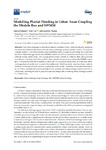Modelling Pluvial Flooding in Urban Areas Coupling the Models Iber and SWMM

Ver/
Use este enlace para citar
http://hdl.handle.net/2183/26668
A non ser que se indique outra cousa, a licenza do ítem descríbese como Atribución 4.0 Internacional
Coleccións
- Investigación (ETSECCP) [826]
Metadatos
Mostrar o rexistro completo do ítemTítulo
Modelling Pluvial Flooding in Urban Areas Coupling the Models Iber and SWMMData
2020Cita bibliográfica
Sañudo, E.; Cea, L.; Puertas, J. Modelling Pluvial Flooding in Urban Areas Coupling the Models Iber and SWMM. Water 2020, 12, 2647. https://doi.org/10.3390/w12092647
Resumo
[Abstract] Dual urban drainage models allow users to simulate pluvial urban flooding by analysing the interaction between the sewer network (minor drainage system) and the overland flow (major drainage system). This work presents a free distribution dual drainage model linking the models Iber and Storm Water Management Model (SWMM), which are a 2D overland flow model and a 1D sewer network model, respectively. The linking methodology consists in a step by step calling process from Iber to a Dynamic-link Library (DLL) that contains the functions in which the SWMM code is split. The work involves the validation of the model in a simplified urban street, in a full-scale urban drainage physical model and in a real urban settlement. The three study cases have been carefully chosen to show and validate the main capabilities of the model. Therefore, the model is developed as a tool that considers the main hydrological and hydraulic processes during a rainfall event in an urban basin, allowing the user to plan, evaluate and design new or existing urban drainage systems in a realistic way.
Palabras chave
Urban drainage
Dual drainage
Iber
SWMM
Urban flooding
Dual drainage
Iber
SWMM
Urban flooding
Versión do editor
Dereitos
Atribución 4.0 Internacional






